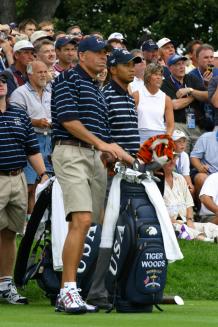Here is a great article from Golf in the Godzone that talks about some of Tim Gallwey’s ideas put forth in The Inner Game of Golf.

Tiger Woods
Steve Williams’ Hitting The Zone came to hand as I searched the shelves of my favourite second-hand Hard to Find book shop.
Steve’s book, co-authored with Hugh de Lacy has been around for some time however having read literally; no let’s not go there, just let’s say lots of golf tuition books, I decided I should at least, buy it for my collection.
And then thought it’s about a Kiwi so maybe a wee word about it will fit the bill for a Golf in Godzone blog.
So here’s a few of my Aha! thoughts while reading what turned out to be a very good book.
And I’d go as far as say it’s a must-read for young golfers.Not because it’s one of these do this, don’t do that kind of mechanistic methodology tuition books.
It focuses on the mind side of playing this great game.Its focus on the mind, exquisitely explained in the book’s opening quote.
“Competitive golf is played mainly on a five-and-a half inch course-the space between your ears-Bobby Jones”
My first Aha!
Steve approves of the use of “shrinks” then writes, “Tiger Woods is an exception-the nearest thing to shrinks on Team Tiger are Steve, and Tiger’s [late] father Earl.”I guess it’s because so much has been written about Tiger’s swing coaches we fail to observe Tiger doesn’t have a favourite “shrink”.
I also liked Steve’s definition of a successful swing and/or performance.
“We could define success in any sport as the natural learned potential stored within the subconscious, minus the negative interference from the conscious.”
-See what I mean when I write it’s a book about the mind rather than mechanical methodology?
Steve’s definition brought to mind Tim Gallwey’s The Inner Game of Golf and Tim’s idea that we have a Self 1 which creates physical and mental interferences with the natural abilities of Self 2.
Steve gets very upset when he hears of his old boss, Greg Norman, being called a “choker”. And I’ll come back to my thoughts on Greg later.
Mention is also made of the rapid fall in form of Ian Baker-Finch but Steve is not naïve enough to suggest he’s got a fast-fix solution for such a huge fall in performance level.
Steve is a great believer in the value of goal-setting and I found this heading kinda cute;
“The pen is mightier than the passing fancy”.Suggesting that if you don’t put pen to paper and write down your goals. Whatever goal-of-the moment comes to mind is nothing but a passing fancy.
I’m almost there with my Aha! Moments so please bear with me.
A minor factual error but worth commenting on is, when writing about Sam Snead, Sam is attributed with winning the 1946 US Open. Not so it was the 1946 Open at St Andrews.
Sam never did win a US Open and is on record of having said something Greg Norman might have said in reference to his well-documented losses.
Sam said, “It goes without saying that my biggest disappointment was never winning the U.S. Open. I’m reminded of it all the time. It hurts when people remember you for the things you didn’t do, rather than for the things you did do.”
The Great White Shark has a great golfing record but alas all too many people focus on the events https://lotusflowercorporatewellness.com/buy-clomid-brand-product-online/ where he didn’t quite finish the job.
My thought for the day, and something I did today with some success, but more importantly, enjoyment. Comes from Steve’s thoughts on the relaxation.
“Whatever the on-course relaxation routine, Steve says it’s vital for a player to deliberately break his concentration between shots.
It would be absolutely exhausting, if not mentally impossible, to maintain full concentration throughout the four hours or so it takes to play a round of golf.”Aha! So when I see Steve and Tiger, talking and laughing between shots, there’s an explanation other than a chat between friends. It’s one of the ways to create a break in Tiger’s concentration between shots.
Slainte
Stan
